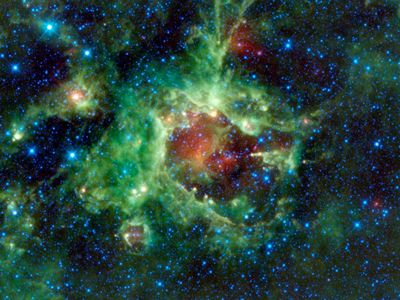
NASA's Wide-field Infrared Survey Explorer, or WISE, captured this image of a star-forming cloud of dust and gas, called Sh2-284, located in the constellation of Monoceros. Lining up along the edges of a cosmic hole are several "elephant trunks" -- or monstrous pillars of dense gas and dust.
The most famous examples of elephant trunks are the "Pillars of Creation" found in an iconic image of the Eagle nebula from NASA's Hubble Space Telescope. In this WISE image, the trunks are seen as small columns of gas stretching toward the center of the void in Sh2-284, The most notable one can be seen on the right side at about the 3 o'clock position. It appears as a closed hand with a finger pointing toward the center of the void. That elephant trunk is about 7 light-years long.
Deep inside Sh2-284 resides an open star cluster, called Dolidze 25, which is emitting vast amounts of radiation in all directions, along with stellar winds. These stellar winds and radiation are clearing out a cavern inside the surrounding gas and dust, creating the void seen in the center. The bright green wall surrounding the cavern shows how far out the gas has been eroded. However, some sections of the original gas cloud were much denser than others, and they were able to resist the erosive power of the radiation and stellar winds. These pockets of dense gas remained and protected the gas "downwind" from them, leaving behind the elephant trunks.
Sh2-284 is relatively isolated at the very end of an outer spiral arm of our Milky Way galaxy. In the night sky, it's located in the opposite direction from the center of the Milky Way.
See the website for more details.
http://www.nasa.gov/mission_pages/WISE/news/wise20110304.html

